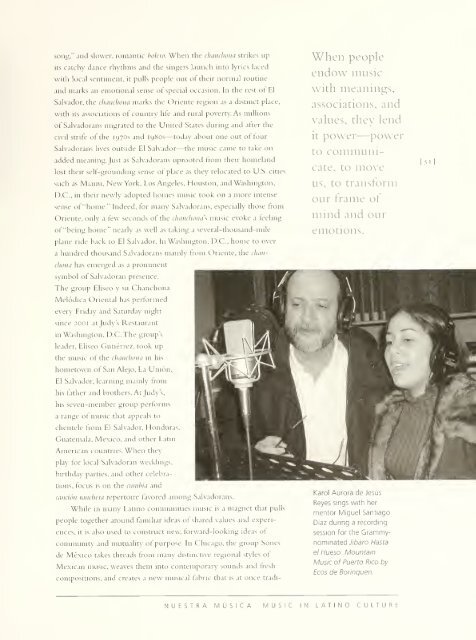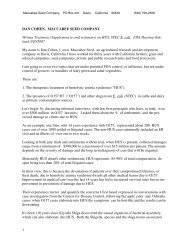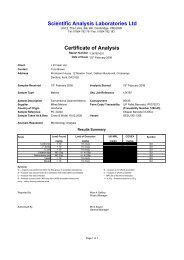plena groups throughout the Northeast andbeyond. In addition to bringing arefreshedsound ot deep tradition to urban listeners, thegroup created new compositions that broughtPuerto Ricans together around current socialissues. One example is the piece "Isla Nena"with its retrain "Isla nena, perla cautiva; tupueblo te liberó de /./ marina" (Little girl island,pearl in captivity; your people liberated you¡o]from the navy) that celebrates the successfulprotests leading the U.S. Navy to abandon useof the island ot Vieques as atiring range.A fundamental cornerstone of community isthe family. Family, in turn, is otten fundamentalto passing on musical traditions, and musicmaking can be an important way ot keepingfamily ties strong .\nd music a lively, integrated,and relevant part ot community lite. In the cattlecountry ot the northeastern Mexican state ofSan Luis Potosí, tor example, the members ofthe trio Los Camperos de Valles, all acclaimedrepresentatives ot the Mexican son huastecomusical tradition, recall the importance ot familyconnections to having taken up their music.Violinist lociMonroy's grandfather Mateo wasa violinist, and an uncle ot his mother's playedguitar, especially at velorios, wakes. At the age oftwelve, Monroy started following his relativesand their musician friends around to parties atneighboring ranches and towns, learning bits andpieces ot how to play the traditional Huastecaninstruments, the jarana and huapanguera (smalland large rhythm guitars). Similarly, his colleagueGregorio "Goyo" Solano started learning jaranafrom his father at the age often. He followedhis violinist lather to local community tiestas.birthday parties, and baptism celebrations, wherehe was hired to play in Huastecan trios. "I gotinvoked m the musical scene, just listening atfirst. My father showed me little by little thebecame part ot the triofinger positions, and 1after having learned a little," he recalls. Likewise,group leader Marcos Hernandez started playingthe huapanguera professionally wath his uncleFortmo at the age ot fifteen. None of theseoutstanding musicians had formal training:The author interviews Los Camperos de Vallesin Ciudad Valles, San Luis Potosí, Mexico, forthe context-providing liner notes as vital to therecord-making process as the music itselfthey were first inspired and trained by theirfamily, the "conservatory ot traditional music."It it were not tor their strong family ties, thismasterful group ot traditional musicians wouldlikely not exist. In the Huastecan region, theson huasteco not only communicates a sense otidentity with the region's shared lifeways but,lor the musicians, carries strong associationswith family and with the "extended family"ofprofession.il Huastecan-style musicians.Another example ot how music buildscommunity is found in El Salvador's mountainous,agricultural Oriente (eastern)region.There, where small villages dot the ruggedlandscape, the centerpiece ot main town andfamily fiestas is the music ot a spirited, uniquelySalvadoran musical ensemble called chanchona.Chanchona literally means big sow, the localname given to the large stringed bass thatprovides the harmonic foundation tor the group.The chanchona emerged inthe latter halt of the20th century, borrowing repertoire from popularmusic from Mexico and other countries mVentral America. Over time a standard instrumentationot six or more members emerged,including chanchona, two violins, guitar, tumba(conga drum), and other percussion. Its grassrootssound focuses on the popular cumbia dancerhythm, fast-paced canción ranchera "countrySMITHSONIAN FOLKLIFE FESTIVAL
song," and slower, romantic bolero. When the chanchona strikes upits catchy dance rhythms and the singers launch into lyrics lacedwith local sentiment, it pulls people out of their normal routineand marks an emotional sense of special occasion. In the rest of ElSalvador, the chanchona marks the Oriente region as a distinct place,with its associations of country life and rural poverty. As millionsof Salvadorans migrated to the United States during and after thecivil strife of the 1970s and 1980s—today about one out of fourSalvadorans lives outside El Salvador—the music came to take onadded meaning. Just as Salvadorans uprooted from their homelandlost their self-grounding sense of place as they relocated to U.S. citiessuch as Miami, New York, Los Angeles, Houston, and Washington,D.C., in their newly adopted homes music took on a more intensesense of "home." Indeed, for many Salvadorans, especially those fromOriente, only a few seconds of the chanchona's music evoke a feelingof "being home" nearly as well as taking a several-thousand-mileplane ride back to El Salvador. In Washington, D.C., home to overa hundred thousand Salvadorans mainly from Oriente, the chanchonahas emerged as a prominentsymbol ot Salvadoran presence.The group Elíseo y su ChanchonaMelódica Oriental has performedevery Friday and Saturday nightsince 2001 at Judy's Restaurantin Washington, D.C.The group'sleader. Elíseo Gutiérrez, took upthe music of the chanchona in hishometown of San Alejo, La Unión,El Salvador, learning mamly fromhis father and brothers. At Judy's,his seven-member group performsa range of music that appeals toclientele from El Salvador, Honduras,Guatemala, Mexico, and other LatinAmerican countries. When theyplay for local Salvadoran weddings,birthday parties, and other celebrations,focus is on the cumbia andcanción ranchera repertoire favored among Salvadorans.While in many Latino communities music is a magnet that pullspeople together around familiar ideas of shared values and experiences,it is also used to construct new, forward-looking ideas otcommunity and mutuality of purpose. In Chicago, the group Sonesde México takes threads from many distinctive regional styles otMexican music, weaves them into contemporary sounds and freshcompositions, and creates a new musical fabric that is at once tradi-When peopleendow musicwith meanings,associations, andvalues, they lendit power — powerto communicate,to moveus, to transformour frame olmind and ouremotions.Karol Aurora de JesúsReyes sings with hermentor Miguel SantiagoDiaz during a recordingsession for the GrammynominatedJibaro Hastael Hueso: MountainMusic of Puerto Rico byEcos de Bonnquen.[51]NUESTRA MÚSICA MUSIC IN LATINO CULTURE
- Page 1: Smithsonianolklife Festival\Food Cu
- Page 4 and 5: The annual Smithsonian Folklite Fes
- Page 7 and 8: —CONTENTSThe Festival's Timely Ap
- Page 9 and 10: —THE FESTIVAL'S TIMELY APPEALLAWR
- Page 11 and 12: COMMERCE FOR CULTUREFrom the Festiv
- Page 13 and 14: [ii]The food concession for the Mel
- Page 15 and 16: oMiiitbioni.indotal SoundL04.A 1 Sl
- Page 17: 1WELCOME TO THE 2005 FOLKLIFE FESTI
- Page 20 and 21: Workers harvest artichokes at Ocean
- Page 22 and 23: —assigned aparticular dish—meat
- Page 24 and 25: I--IPot Pie Farm manager Elizabeth
- Page 26 and 27: ISustainable farmers such as Eliot
- Page 28 and 29: "IThe numberof programsdesignedfor
- Page 30 and 31: .hadSALAD GREENS WITH GOAT CHEESE,
- Page 32 and 33: w.A>wm:~
- Page 34 and 35: —3 3]OCCUPATIONAL CULTUREThe 2005
- Page 36 and 37: employees, the USDA Forest Servicei
- Page 38 and 39: I[3 6]page book, which could fit in
- Page 40 and 41: ká.!i- .>!mKPA backpacker sets up
- Page 42 and 43: --^i'liunterw eight jihI ...itl jib
- Page 44 and 45: —4-"The essentialpiece isto captu
- Page 46 and 47: I44cutDUTCH OVENONE-POT MEALThomas
- Page 48 and 49: —FUTURE CONCERNS FOR PUBLIC LANDS
- Page 50 and 51: NUESTRA MÚSICA: MUSIC INBuilding C
- Page 54 and 55: NUESTRA MÚSICA LAUNCHES NEW SERIES
- Page 56 and 57: NUESTRA MÚSICA: MUSIC IN LATINO CU
- Page 58 and 59: "ILos Camperos de Valles son músic
- Page 60 and 61: RAICES LATINASNUESTRA MÚSICA LANZA
- Page 63 and 64: IOMAN: DESERT, OASIS, AND SEARICHAR
- Page 65 and 66: DESERTThe deserts ot the Arabian Pe
- Page 67 and 68: THE FESTIVAL PROGRAMThe 200s Smiths
- Page 70 and 71: 6 8The coiled, leather-covered bask
- Page 72 and 73: 70]COASTAL CRAFTSMANSHIPAND GLOBAL
- Page 74 and 75: [72]Although the oldismaking way fo
- Page 76 and 77: AN OMANI FOLKTALEASYAH AL-BUALYOman
- Page 79 and 80: y%aMUSIC AND DANCE INOMANOMAN CENTR
- Page 81: In the southern Dhufar region, al-b
- Page 84 and 85: ecosystems, identification of plant
- Page 86 and 87: 2:00IIIVorkshopFESTIVAL SCHEDULE (P
- Page 88 and 89: Rhythm,Saturday, June 25 (Programs
- Page 90 and 91: )avidi nestMonday, June 27(Programs
- Page 92 and 93: 1:00IIlamFriday, July 1 (Programs a
- Page 94 and 95: )utchSunday, July 3(Programs are su
- Page 96 and 97: EVENING CONCERTSSounds of the Fores
- Page 98 and 99: theRELATED EVENTS[96]Nuestra Músic
- Page 100 and 101: IIDónalas Anderson,Washington, D.C
- Page 102 and 103:
'IEd LiíDmi, Studio City, Californ
- Page 104 and 105:
ISudhir Seth, Bethesda, MarylandA g
- Page 106 and 107:
1 if 1 DumberHoneyBeehive Beeproduc
- Page 108 and 109:
1"''NewI >onI Lui\IDon Bustos,Espa
- Page 110 and 111:
Ian Barlow, White Bird,Idaho; Woodl
- Page 112 and 113:
I 'istnet1Gordon Grant,Corvallis, O
- Page 114 and 115:
Kristen Marline, Flagstaff,Arizona;
- Page 116 and 117:
I1 ountries,IIHistorie Site, once t
- Page 118 and 119:
1IworksI1 11Istations are vital to
- Page 120 and 121:
1'IenIpanderetas;JCJ Band. Washingt
- Page 122 and 123:
Ralph Rinzlersongs are "made" (or c
- Page 124 and 125:
I >cmseI VhorahII MiI lameEne Nance
- Page 126 and 127:
|i 2forIIBartlevy1 )oerr;IIParadeSP
- Page 128 and 129:
II AerialIIII1Washington and Jeffer
- Page 130 and 131:
Stack, Bill Stafford, loni Stafford
- Page 132 and 133:
SMITHSONIAN FOLKLIFE FESTIVAL 20051
- Page 135 and 136:
SMITHSONIAN FOLKLIFE FESTIVAL 2005B
- Page 138:
Smithsonian Folklife FestivalSMITHS








